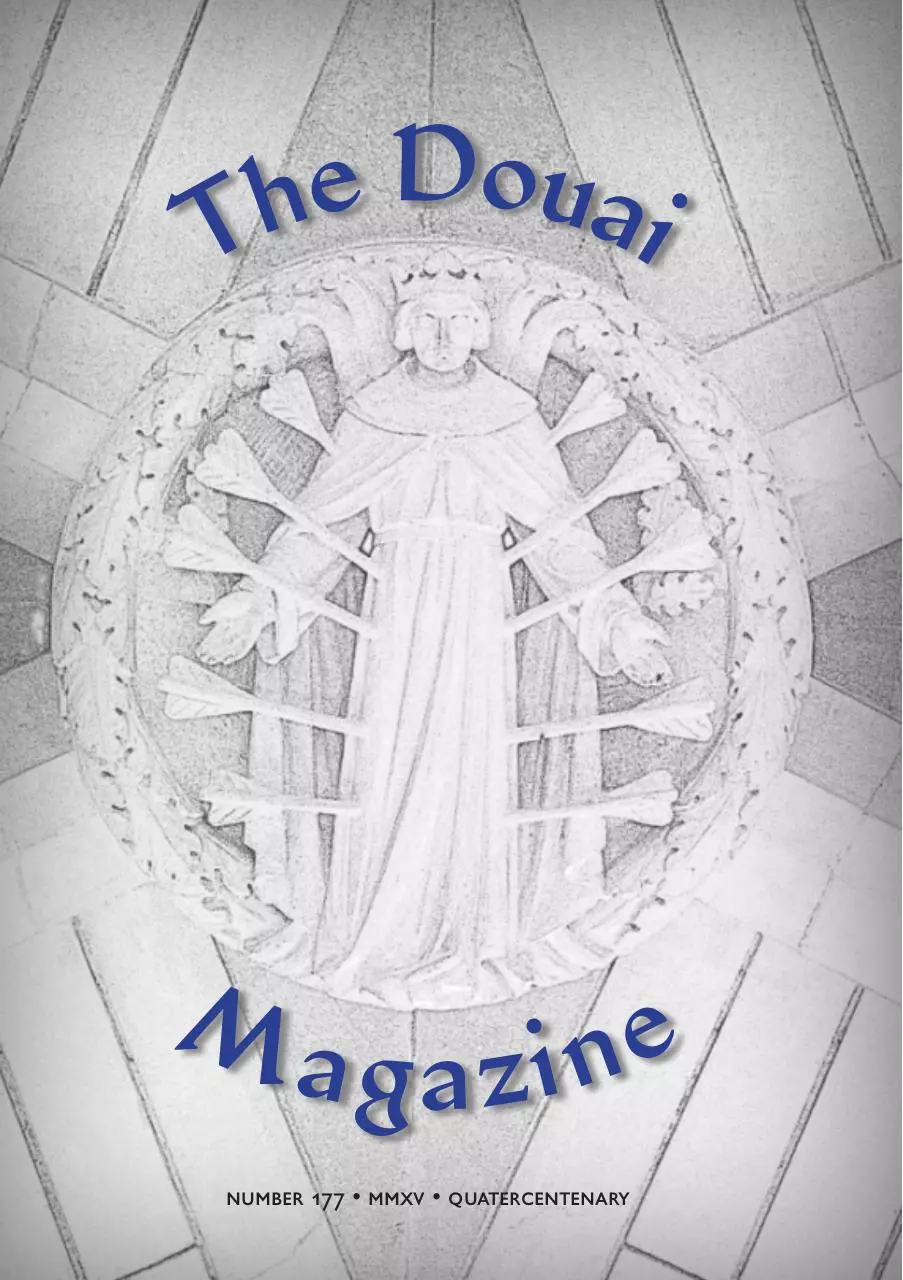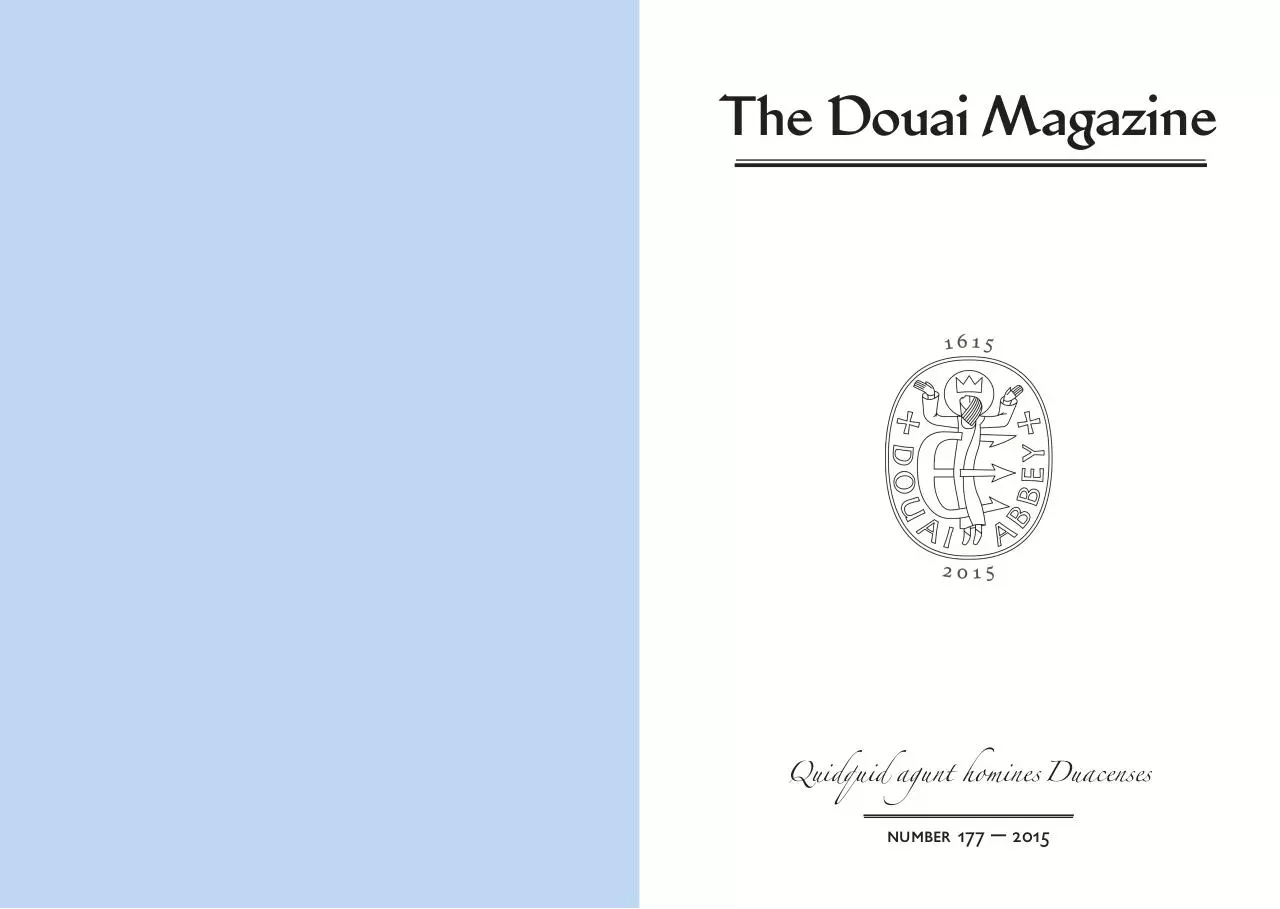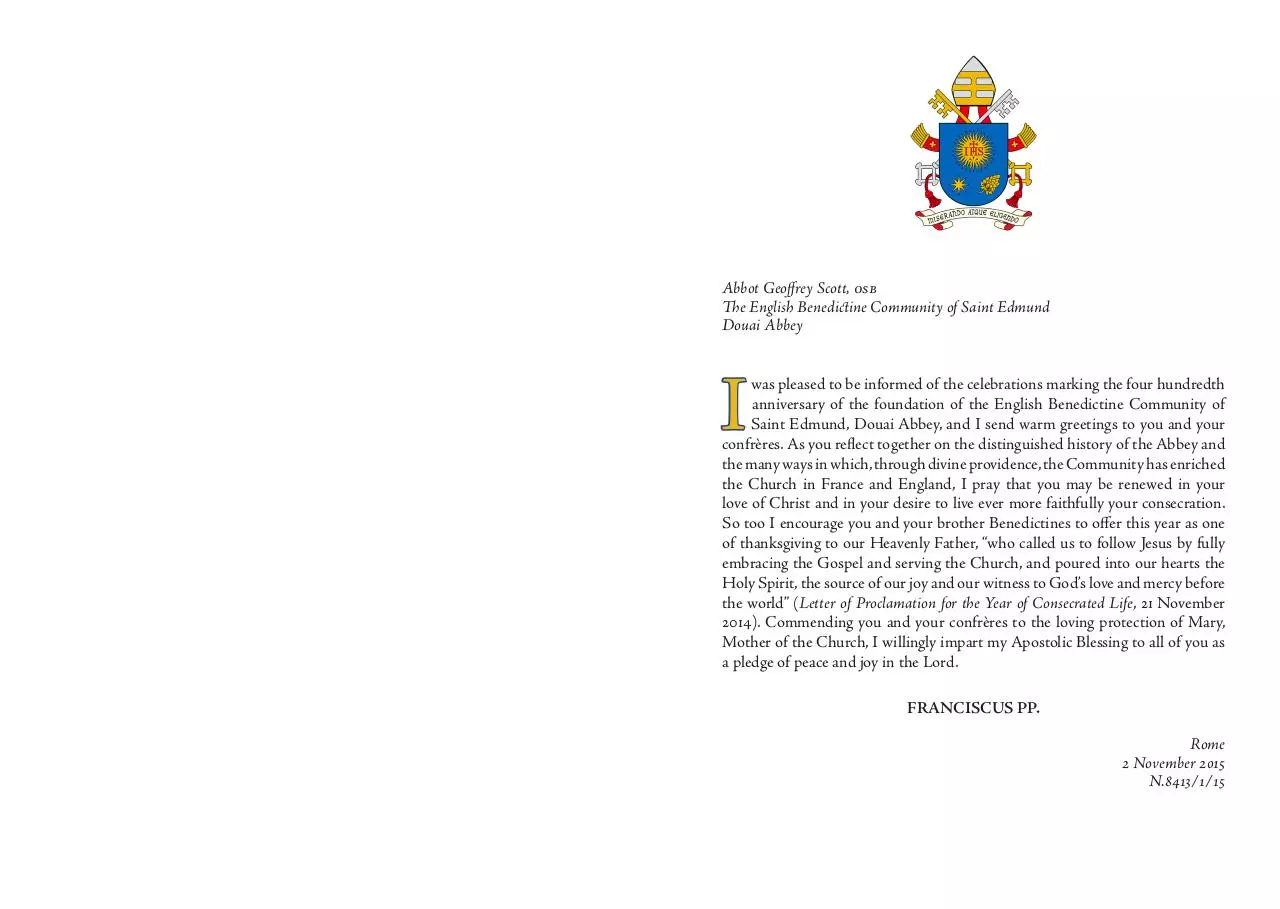Douai Mag 2015 with COVER (PDF)
File information
This PDF 1.4 document has been generated by Adobe InDesign CS6 (Macintosh) / Adobe PDF Library 10.0.1, and has been sent on pdf-archive.com on 19/04/2016 at 17:54, from IP address 213.146.x.x.
The current document download page has been viewed 961 times.
File size: 25.13 MB (73 pages).
Privacy: public file





File preview
D
o
u
e
a
h
i
T
Ma
e
n
g a zi
Number 177 • MMXV • Quatercentenary
The Douai Magazine
Quidquid agunt homines Duacenses
Number 177 ─ 2015
Abbot Geoffrey Scott, OSB
The English Benedictine Community of Saint Edmund
Douai Abbey
I
was pleased to be informed of the celebrations marking the four hundredth
anniversary of the foundation of the English Benedictine Community of
Saint Edmund, Douai Abbey, and I send warm greetings to you and your
confrères. As you reflect together on the distinguished history of the Abbey and
the many ways in which, through divine providence, the Community has enriched
the Church in France and England, I pray that you may be renewed in your
love of Christ and in your desire to live ever more faithfully your consecration.
So too I encourage you and your brother Benedictines to offer this year as one
of thanksgiving to our Heavenly Father, “who called us to follow Jesus by fully
embracing the Gospel and serving the Church, and poured into our hearts the
Holy Spirit, the source of our joy and our witness to God’s love and mercy before
the world” (Letter of Proclamation for the Year of Consecrated Life, 21 November
2014). Commending you and your confrères to the loving protection of Mary,
Mother of the Church, I willingly impart my Apostolic Blessing to all of you as
a pledge of peace and joy in the Lord.
FRANCISCUS PP.
Rome
2 November 2015
N.8413/1/15
Contents
The Douai Magazine, no. 177, Easter Sunday 2016
The Douai Magazine is published by the
Trustees of Douai Abbey,
Upper Woolhampton, Berkshire, RG7 5TQ
All rights reserved
Opinions expressed herein are the authors’ own and are not necessarily shared
by the Douai community or the Trustees of Douai Abbey.
Papal Greeting and Blessing
3
Foreword
7
The Quatercentennial of Foundation
9
• The Community Pilgrimage to Paris
15
• The Homily of Abbot Geoffrey Scott in Paris
19
• The Solemnity of St Edmund
22
• Abbot Aidan Bellenger’s Colloquy
25
• Abbot Cuthbert Madden’s Homily
33
• The Bishop of St Edmundsbury’s Sermon
37
• The Provost of Portsmouth’s Homily
43
• The Wintour Vestments
48
• The Malvern Cope
52
• The New Statue of St Edmund
54
• The New Hymn to St Edmund
58
• The New Logo
59
• The Consecrated Life Colloquies
60
Portrayals of St Edmund, King & Martyr,
after the Reformation
62
The Reception of Vatican II at Douai in the 1960s & 70s
81
The EBC Forum & Extraordinary General Chapter
94
The Refoundation of the Dutch Dominican Province
98
Obituaries
100
(+44) 0118 971 5300
www.douaiabbey.org.uk — info@douaiabbey.org.uk
Book Reviews
111
Community Chronicle
122
{ Registered Charity No. 236962 {
Community List
137
Foreword
I
cannot let this year go by without referring to the grand
celebrations to mark the 400th anniversary of the community’s
foundation in Paris in June, 1615. The visit to Paris in June 2015
and the 20 November Mass at Douai for the Solemnity of St Edmund,
our patron, were both magnificent events. We are grateful to all
those who organised and supported the community.
Our celebrations, in which red, representing the blood of martyrs,
was a predominant colour throughout, made me conscious of the
debt the Church owes to the witness of its martyrs. Uppermost in my
thoughts during 2015 was the news which we all heard of Christians
martyred for their faith in the Middle East. These contemporary
witnesses to Christ take their place alongside St Edmund, the young
Anglo-Saxon king of East Anglia martyred in 869/70 by the Vikings,
the terrorists of his day.
The French government refused to return to the Douai community
the large painting of St Edmund’s martyrdom by Charles de La Fosse
(1636–1716) which was the centrepiece of the monks’ chapel in Paris
and which depicts concerned cherubs pulling arrowheads out of
the saint’s torso. We were told it was national patrimony and must
therefore remain in France. A worthy substitute for this portrait,
however, has been the poignant carving in wood of the martyrdom
of St Edmund which was blessed by Vincent, Cardinal Nichols at
Vespers on 20 November.
Above: Fr Alban chanting the gospel at Mass on St Edmund’s day, assisted by
Br Alexander Bellew (left) and Christopher Webb (right)
Below: Cardinal Nichols blesses the new statue of St Edmund in the abbey
church after Vespers on St Edmund’s day, assisted by Michael Webb
Sometimes we are granted a deeper insight through surprising
coincidences. Peter Eugene Ball is the carver of the statue, and in
its very early stages, he came upon a Moorish silver filigree brooch
into which were inserted five semi-precious carnelian (flesh-red)
stones. This, he said, would be used as the shoulder brooch for the
saint’s cloak. Now the five red circles are an ancient symbol of the
five wounds of Our Lord: the hands, the feet, and the side. So here
was a carver, quite unwittingly, using a piece of Islamic jewellery
bearing the symbols of Our Lord’s passion and death of which the
Muslim craftsman would not have had the faintest idea. And Peter
Eugene Ball superimposed the jewel over our martyr’s heart. All
Christian martyrs, including our St Edmund, are sharers in Christ’s
own martyrdom. “He is a true martyr who sheds his blood for
Christ's name”.
9
To take my reflection on Christian martyrdom and death further,
I would like to think that the statue of St Edmund will not be our
only tangible reminder of our quatercentennial. While we were
conducting our own celebrations, quiet preparations began on the
construction of the new cricket pavilion which will also remind
us of this past year. We are grateful to the Douai Park Recreation
Association, especially Richard Morris, and to the Douai Society
for their sustained efforts to make a reality of their dream. I am
assured that the new pavilion will display a plaque to acknowledge
the dedication of the original pavilion as a war memorial.
The Quatercentenary of
Foundation: The Paris Years
2015
offered the first real opportunity for the Douai
community to commemorate fittingly its anniversary
of foundation. It is not recorded whether the event was marked
in any way in the year 1715; in 1815 the few remaining members
of the community were scattered without a permanent home; and
in 1915 the resident community was living in cramped conditions
at a time of wartime austerity. It was decided to celebrate both the
tercentenary of foundation and the centenary of the community’s
re-establishment in Douai in 1918 by the publication of Tercentenary
of St Edmund’s Monastery, edited by Fr Cuthbert Doyle and published
in 1917. In 2003 we had celebrated the centenary of our arrival
at Woolhampton with another book and a Pontifical High Mass.
Several meetings were held to float ideas for celebrating the 400th
anniversary and serious planning began in earnest in October 2013.
It was decided to hold two major celebrations—one in Paris around
the date of foundation in June, and the other in Woolhampton on
the Solemnity of the community’s patron, St Edmund, King and
Martyr, on 20 November.
The old pavilion was built in 1922 to commemorate the Old
Dowegians who had fallen in the Great War. In a sense, they too
were martyrs. So, it was a strange experience for me the other day
to drive past the old pavilion and to see that the demolition firm
had flattened all of it except the entire frontage. One could look for
the first time in the sunlight through the front windows of this war
memorial and see the Catholic section of St Peter’s graveyard as well
as the spire of the parish church. Cruel death and earthly decay lead
towards resurrection.
Centenaries commemorate the past in order to provide hope for
the future, and though we now see through a glass darkly, Christian
hope is anchored in our belief that all sin and death are ultimately
swallowed up in the victory of our resurrection in Christ.
Community life had begun in Paris in 1615, when a group of six
English monks from the monastery of St Laurence at Dieulouard in
Lorraine (now at Ampleforth) arrived in Paris to erect a Benedictine
house of studies under the earthly patronage of Princess Marie de
Lorraine, abbess of the ancient Royal Abbey of Chelles. Among this
group of six was the future martyr-saint, Alban Roe. The first superior
was Fr Augustine Bradshaw, who had established St Gregory’s in
Douai (now at Downside) as well as St Laurence’s in Dieulouard.
The date of his installation, 25 June 1615, marks the date of the
foundation of the community. It was to take another 60 years for the
community to obtain suitable buildings and anything like a sound
financial basis. It was 1632 before the existence of the community
was securely established, and 1642 before it was able to purchase
property in Paris. Royal letters of establishment were obtained in
1650, full ecclesiastical recognition as a monastery in 1656, and the
foundations of the church and monastery were laid in 1674.
Abbot Geoffrey Scott OSB
{
The six monks were presumably to study in Paris in preparation
for missionary labours but their first priority, however, would have
10
11
been to establish a monastic routine. The annals record the customs
of the house: Matins and Lauds were at four in the morning, Mass
for the community was at eleven, followed by dinner and recreation
until two o’clock. Eating in the morning was allowed only on
Christmas Day, Shrove Monday and Tuesday, and Laetare Sunday,
and in recreation weeks (of which there were three in the year,
as designated by the superior). After dinner the community sang
Vespers, which was followed immediately by a period of meditation
until three. According to the custom of the time, the little hours of
Prime, Terce, Sext and None were not said separately but immediately
following on from Lauds, or in the case of None, perhaps together
with Vespers. The hours between Lauds and Mass, and between
meditation and supper, provided ample time to attend lectures,
study and carry out necessary work. Long walks were a standard
medical recommendation for those who led largely sedentary lives,
and twice a month there was an expedition “into the fields”, the Left
Bank suburbs where the community lived still being on the very
edge of the countryside.
The early seventeenth century saw the patronage of many of the
great abbeys of France, including Chelles, pass from the House of
Lorraine to the House of Bourbon. That the community in Paris was
established under the patronage of Lorraine, and from St Laurence’s
in Dieulouard, would have made the monks suspect to some French
royalists, and prevented any immediate identification with the
interests of the French crown. Ultimately a secure foundation was
only obtained by placing the community under the patronage of
the King of France, but that step was not taken for some time. The
connection with the House of Lorraine, so important in the first
founding of the community, was soon broken off. The exact reasons
are unclear, but seem to have something to do with the difficulties
surrounding the formation of the revived English Benedictine
Congregation, which was ratified by the Papal bull Plantata in agro
Dominico veneranda Congregatio monachorum Anglorum of 1633.
William Gabriel Gifford, the third superior at Paris (1617–18) is
credited as “the first superior to have the title and dignity of Prior of
the house and was really its founder as an independent monastery”.
He had been clothed as a Benedictine in Dieulouard in 1608 and
became prior of the short-lived monastery of St Benedict at St Malo
in 1611. He was a great preacher, and was often invited to preach in
Paris, where he was renowned for his eloquence and came to be very
well connected, even the young Louis XIII attending several of his
sermons. In 1618 he was consecrated coadjutor bishop to Princess
Marie’s cousin, Louis de Lorraine, Cardinal Guise, the Archbishop
of Rheims. On 23 September 1618, in the Abbey of Saint-Germaindes-Prés, Gifford became the first Englishman in over 60 years to be
ordained a Catholic bishop. In 1622 he succeeded as Archbishop of
Rheims. With his royal connections, Gifford was able to assist the
Paris community in finally purchasing a property in the main street
of the Faubourg Saint-Jacques. It was to be to Rue Saint-Jacques
that the community returned in 1632, and where they resided until
after the French Revolution. Gifford’s combination of active pastoral
concern with calculated political manœuvring enabled him to
become a valuable patron not only to the Paris monks, but to all the
English Benedictines in France.
The first decades of the Paris house were full of uncertainty. The
monastery was set up at a time of bitter controversies within English
Catholicism, and among the English Benedictines themselves.
The founding members of the community hoped to establish an
institution which would make it possible for themselves and other
Englishmen to lead lives of prayer and study according to the Rule
of St Benedict, either as conventual monks or in preparation for
missionary activity in England. To do this in a foreign country they
were dependent on the good will and the patronage of influential
figures for whom the English monks, and the whole of the English
mission, were of quite minor importance in the larger picture of
religious reform and confessional politics.
St Edmund’s had five different superiors in the first six years,
and after spending a month in temporary accommodation in the
Collège Montaigu, the community moved house five times in its
first 27 years. It was only in 1620, while living in their second house,
that the community was stable enough to start clothing novices and
preparing them for the life of monastic missionaries.
Another valuable patron was Cardinal Richelieu, chief minister
to King Louis XIII, who in 1639 granted an annual pension to St
Edmund’s of 72 livres. Richelieu became commendatory Abbot of
Cluny, and in this capacity he made over to Francis Walgrave, the
Dieulouard monk who had been sent as senior chaplain to Chelles
The position of the English monks who arrived in Paris in 1615
was made easier by the brief calming of the international situation.
June 1615 saw the signing of the Treaty of Asti, which ended the First
Mantuan War: for the first time since 1585 England, France, Spain,
Italy, the Empire and the Low Countries were all at peace.
12
13
in 1611, the priory of La Celle-en-Brie near Meaux, to the east of
Paris, which in 1637 was transferred to the prior of St. Edmund’s.
The priory at La Celle brought with it an annual income of 800
livres, and a personal pension to Walgrave of 400 livres throughout
his lifetime. The priory had a large mediæval church, conventual
buildings and its own liturgical ceremonial. La Celle was only
fully incorporated into St Edmund’s in 1708. It provided a welcome
country retreat at a time when the Left Bank suburbs of Paris were
becoming increasingly built up. There was also a small school at
La Celle from about 1663, which by the middle of the eighteenth
century numbered about a dozen boys.
The composition of St Edmund’s in its early decades in Paris
shows that it was largely serving as a house of studies for the other
English Benedictine monasteries. Monks from Douai, Dieulouard or
St Malo studied a few years in Paris before going on the Mission or
returning to the house of their profession.
In 1632 the Paris community returned to the Rue Saint-Jacques,
and in 1642 the Archbishop of Paris authorised the establishment
of a religious community there and the opening of a public chapel,
where the monks were permitted to hear the confessions of the
English, Scots and Irish resident in the city, except during the Easter
season, when those who could speak French were bound to make
their annual confession in the parish in which they lived.
Above: St Edmund’s, Les Benedictins Anglais, on the 1775 Jaillot map of Paris
Below: St Edmund’s, Benedictins Anglois, on the 1739 Turgot map of Paris
St Edmund’s was also the most important Jacobite centre in Paris,
since it contained the mortuary chapel of the exiled King James II
and his daughter, Marie Louise. The King visited the monastery at
least four times and after his death in September 1701, according to
his wishes, his body was taken to St Edmund’s where it was placed
on trestles and covered with a black velvet pall, with the king’s
death mask alongside. It remained so until the French Revolution.
As a Jacobite centre, St Edmund’s was visited by English Catholics
who remained loyal to the Stuart cause.
In 1789, the resident community numbered fifteen choir monks
and two lay-brothers. By 1793, there were only nine monks attached
to the community, some living elsewhere. One of these was Fr
John Turner, who became a national guardsman and was given
a licence to teach English in the city. In October 1793, following
the confiscation of British property, the authorities took over the
monastery and imprisoned the community in it. The monks were
freed the following year, and in January 1795 their monastery was
14
15
returned to them. The prior, Fr Henry Parker, remained there until
the summer of 1803, when as the new director of the former British
establishments in France, he began to live at the nearby Irish College
in Paris, taking the archives of the monastery with him. He was the
last Edmundian to reside in Paris, and his death in 1817 brought two
centuries of the community’s sojourn in that city to a close.
Fr Alban Hood OSB
The Community Pilgrimage to
Paris
O
n Monday 22 June eight monks, including Abbot Geoffrey
Scott, travelled by Eurostar to Paris, where the community
was originally founded.
The following morning a Mass of Thanksgiving was celebrated in
the chapel of the former Irish College, now the Irish Cultural Centre.
It was here that the last Benedictine prior of Paris, Fr Henry Parker,
took refuge during the French Revolution when the monks were
forced to leave their monastery in the nearby Rue Saint-Jacques. The
famous altar piece of the priory chapel depicting the martyrdom of
St Edmund, King and Martyr, was taken to the Irish College, where
it is now displayed in one of the reception rooms (above).
Abbot Geoffrey was the principal celebrant at the Mass on 23
June. Among the concelebrants joining the community were
monks from the monasteries of Solesmes and Ligugé; the Oratorian
Above: N. Guérard’s engraving of a monk at prayer before the catafalque of King
James II at rest in the church of St Edmund’s in Paris. (Ashmolean Museum, Oxford)
16
17
Download Douai Mag 2015 with COVER
Douai Mag 2015 with COVER.pdf (PDF, 25.13 MB)
Download PDF
Share this file on social networks
Link to this page
Permanent link
Use the permanent link to the download page to share your document on Facebook, Twitter, LinkedIn, or directly with a contact by e-Mail, Messenger, Whatsapp, Line..
Short link
Use the short link to share your document on Twitter or by text message (SMS)
HTML Code
Copy the following HTML code to share your document on a Website or Blog
QR Code to this page

This file has been shared publicly by a user of PDF Archive.
Document ID: 0000362344.